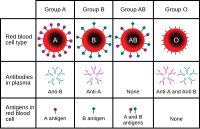
Photo from wikipedia
Objectives Blood bank centers routinely screen for hepatitis B virus (HBV), hepatitis C virus (HCV), and human immunodeficiency virus (HIV) to ensure the safety of blood supply and thus prevent… Click to show full abstract
Objectives Blood bank centers routinely screen for hepatitis B virus (HBV), hepatitis C virus (HCV), and human immunodeficiency virus (HIV) to ensure the safety of blood supply and thus prevent the dissemination of these viruses via blood transfusion. We sought to evaluate the detection of transfusion-transmitted infection (TTI) markers using standard serological methods and nucleic acid testing (NAT) among blood donors in Hospital Universiti Sains Malaysia. Methods Donated blood units were assessed for the presence or absence of HBV, HCV, and HIV using two screening method: serology and NAT. Reactive blood samples were then subjected to serological confirmatory and NAT discriminatory assays. Results A total of 9669 donors were recruited from September 2017 to June 2018. Among these, 36 donors were reactive either for HBV, HCV, or HIV by serological testing and eight by NAT screening. However, only 10 (three for HBV and seven for HCV) donors tested positive using serological testing and five (two for HBV and three for HCV) by NAT discriminatory assays. Note that all five NAT positive donors detected in the NAT discriminatory assays were confirmed to be serologically reactive. Therefore, the prevalence of HBV, HCV, and HIV was 0.03%, 0.1%, and 0.0%, respectively, in our donor pool. Conclusions Both serological and NAT screening and confirmatory assays should be used routinely to reduce the risk of infection transmission via the transfusion of blood and blood components.
Journal Title: Oman Medical Journal
Year Published: 2020
Link to full text (if available)
Share on Social Media: Sign Up to like & get
recommendations!